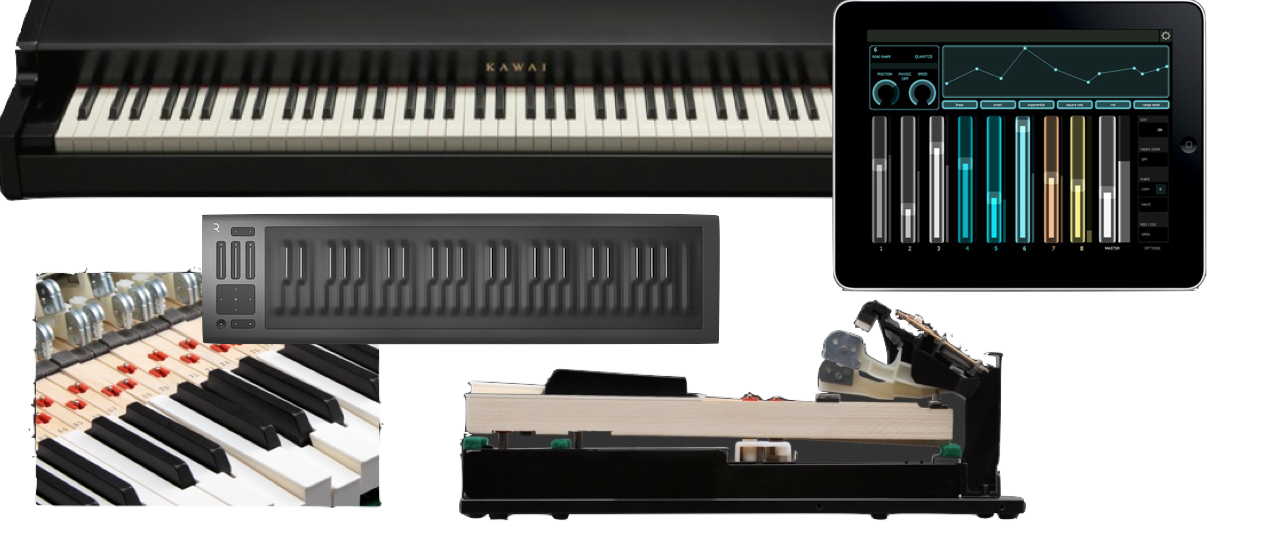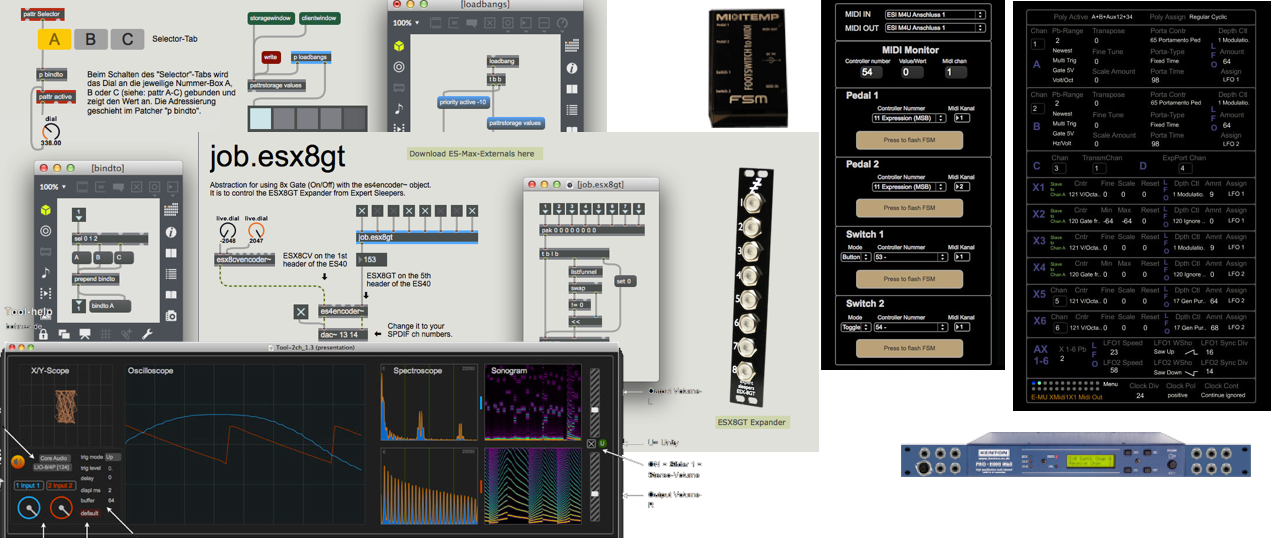MAX
Cycling74MAX - Software Programming Environment
The graphical, object-oriented programming language and real-time environment "MAX" was developed since the mid-80s by Miller Puckette at IRCAM in Paris and "released" in 1990/91, i.e. sold to the company Opcode. Even if it looks a bit different, MAX also originates from the MUSICn philosophy and already shows its reference to Max Mathews by its name "MAX". Since being introduced, "MAX" has constantly evolved. It was detached from its computing engine (the FTS system at IRCAM) for release and became a fully-fledged industrial product (Max IRCAM/OpCode) for the Apple computer platform. In 1997, "Cycling '74" was established by David Zicarelli, who had been involved in the development programming environment Max since the late 1980s. The company initially sold an (audio) add-on to MAX, called MSP, to Opcode, but (fortunately) soon took over all development and distribution of MAX itself. In the meantime, MAX has been extended by various add-ons, including audio, video and robotics. In the more than 30 years of its existence, MAX has also become the "standard" at music academies.
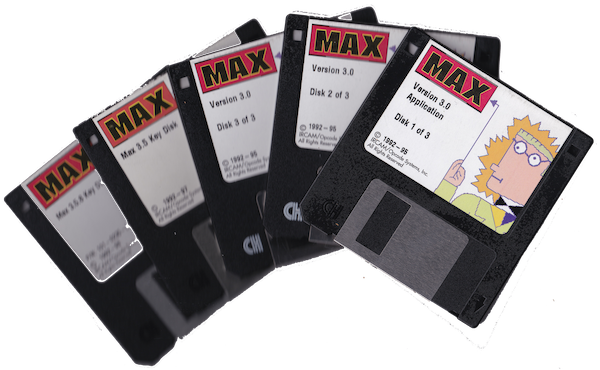
For information about what MAX can do (in the meantime) and what it is good for, I recommend the website Cycling74 (link see above) - not only would it go beyond the extent of my website, I also don't know (anymore) about all areas of MAX. The "package" MAX has become so extensive that "under normal circumstances" one will not be intrigued by all sections, but only by those that are relevant for one's personal field of work.
By now, you can design very nice GUIs (Graphical User Interfaces) in "Presentation Mode" for MAX patches - that is, the things that can be seen on the screen during the application of the patch. There is also M4L (Max for Live), which are plug-ins that can be read and used by the software "Ableton Life". The latest craze is "RNBO", a new patching environment "for exporting software with the sound of Max". This ranges from external devices to web applications to plug-ins in audio software. Finally there is a "Package Manager", which contains many external special solutions from Max users. Very interesting packages can be found there - with "Bach" and "Cage" also packages for musical scores.
For me MAX is par excellence "the" software on my computer. I do "everything" with it, from controlling analog modular synthesizers, DSP (Digital Signal Processing), light control, live video, programming my own password generator, to calculating bible numbers (my "hobby" since the 90s).
Since 2014, the iPad app "MIRA" has also been added, which I really, really appreciate. It allows to "mirror" (some, not all) MAX objects on the iPad. This is done by simply placing a frame into the MAX patch, on which the objects to be mirrored are arranged as they should be seen on the iPad. This is my "control patch" for the Roli RISE keyboard. It's primarily a MIDI monitor, enhanced with the RISE's settings capabilities. This way I not only can adjust the settings, but also check if everything is sent the way I set it. Because it was "convenient", I added distribution curves to the "5 Dimensions" of the RISE for the values generated by the RISE. The upper row (Strike, Glide, Slide, Press, Lift) sets how the RISE reacts to the performer's playing style and the lower row (with the same labels) generates an interpretation / distribution of the incoming controller values for the performer's use in the patch.
Another elementary point, for me, was for the computer now not to be in front of the performer. Since then, I have set up my software as "Terminal" (in tabs) and only the MIDI controller and iPad are now at the instrument, respectively the hands of the performer.
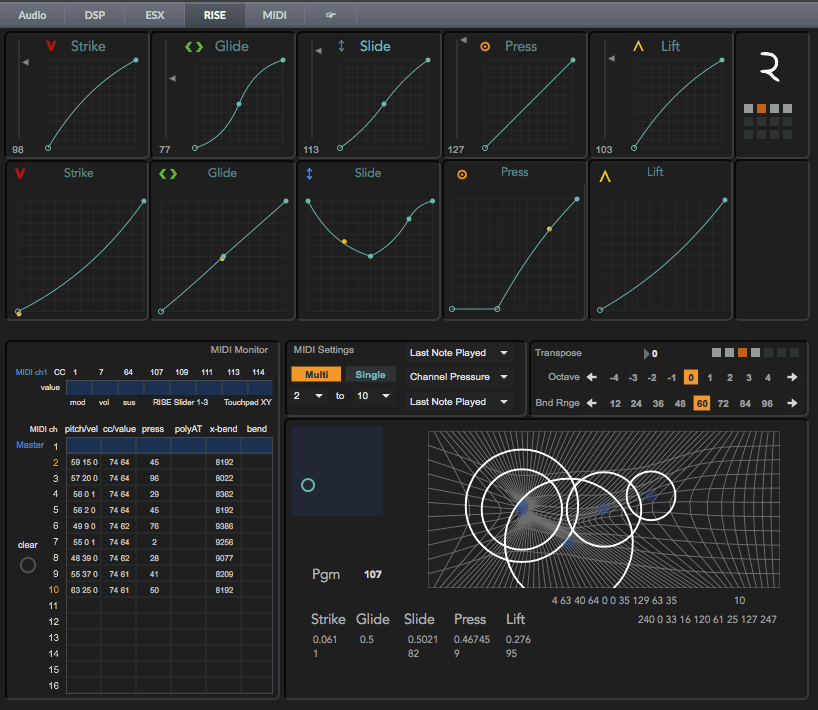
There is simply nothing more displeasing on stage than a performer sitting behind a computer (possibly wearing glasses, which reflect the screen's light on both glasses into the audience). The reflection disturbs the concentration and many spectators wonder what it is that the artist might be doing there...
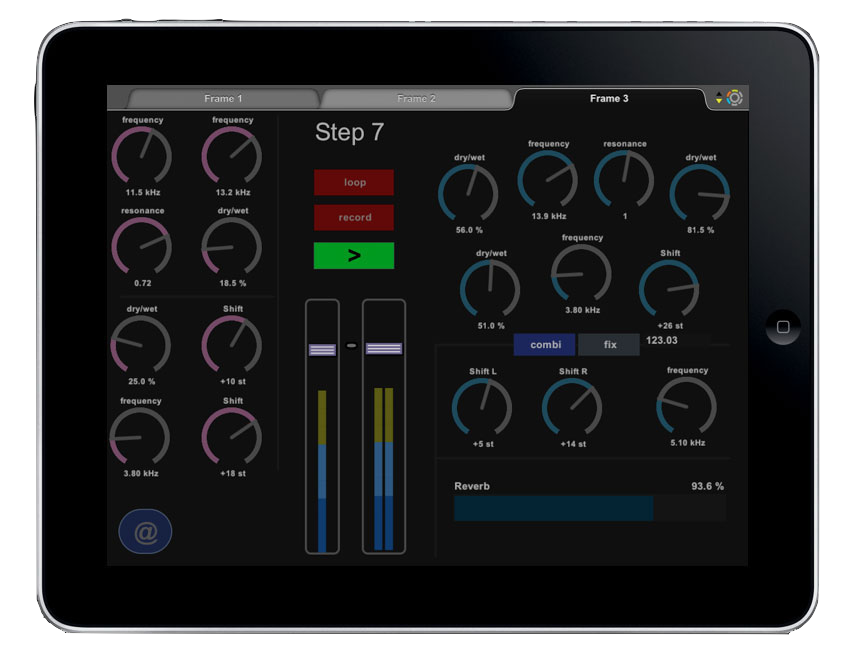 Now the visible controllers on the iPad itself turned out to be the sliders, knobs or XY-pads. Gone are the days when a mouse or trackpad (while keeping the computer monitor visually fixed) was almost unavoidable. Instead of a MIDI fader bank, the iPad now resided with the performer and could look like this, as an example.
Now the visible controllers on the iPad itself turned out to be the sliders, knobs or XY-pads. Gone are the days when a mouse or trackpad (while keeping the computer monitor visually fixed) was almost unavoidable. Instead of a MIDI fader bank, the iPad now resided with the performer and could look like this, as an example.
Three further advantages were that firstly the visible surfaces could be changed easily (in this example they were connected to the "steps") and secondly not always 8 hardware sliders or pots, always next to each other, mostly also too narrowly. Now control surfaces could be "individualized". The third advantage is also enormous, because now you don't have to code extra patches for your controller actions. Especially integrating motorfaders was previously often the largest (and time consuming) work for a MAX performance patch.
MAX is also a perfect “problem solver” for me. Many devices are equipped with a digital controller and have MIDI. Making settings via the hardware is usually a nerve-wracking process. In the best case, devices can be controlled or at least configured more extensively via SysEx messages:
Editor for the Kenton “Modular Solo” Module
As I found the operation of the Kenton Modular Solo module extremely unpleasant, I programmed an Editor. Operating all the settings via three pushbuttons on the module is outdated and the manual with the list of parameters is required, as the rapidly scrolling abbreviations for the parameter designations on the three-digit LCD are almost impossible to read (and understand). The Editor takes the operability into present times.

Using the Editor on an iPad (with the MIRA app) is unbeatable - a real pleasure! I placed the clocks of the Kenton Modular Solo (and a few system settings) in a second TAB. No other controller can do it like this.
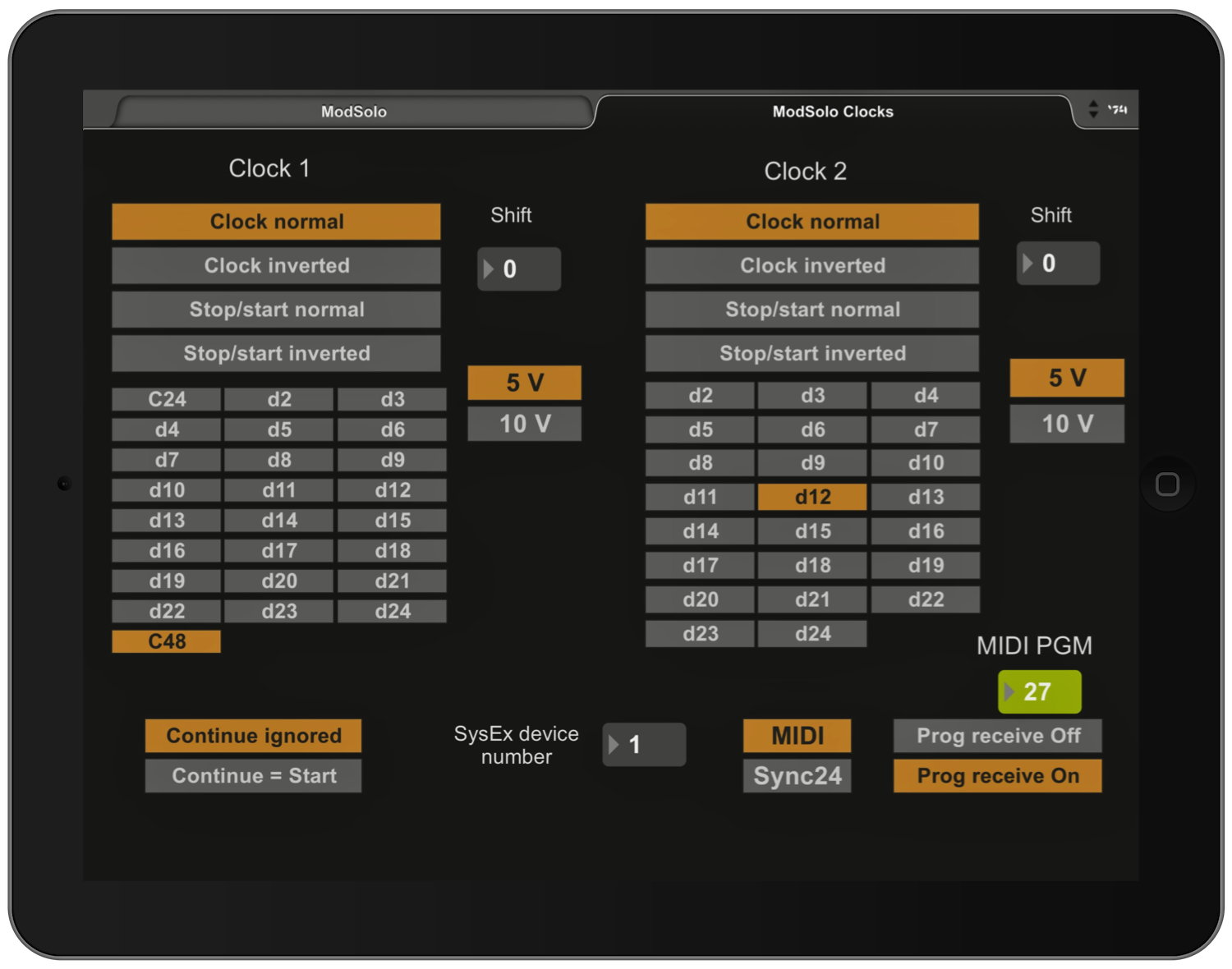
There are still so many devices or instruments with MIDI that are so unpleasant to program on the device itself that they are ultimately no longer used. This is where an Editor can have a life-prolonging effect, as it makes all the instrument's parameters visible and brings usability up to today's level. Here, communication between MAX and the MIDI device takes place via SysEx (System Exclusive Data).
Besides, I have solved the “manual problem” (constantly looking in the pdf manual) by inserting the texts for the individual parameters as a “hint”. They appear when you hover the mouse pointer over the parameter of the MAX-patch (see next picture).
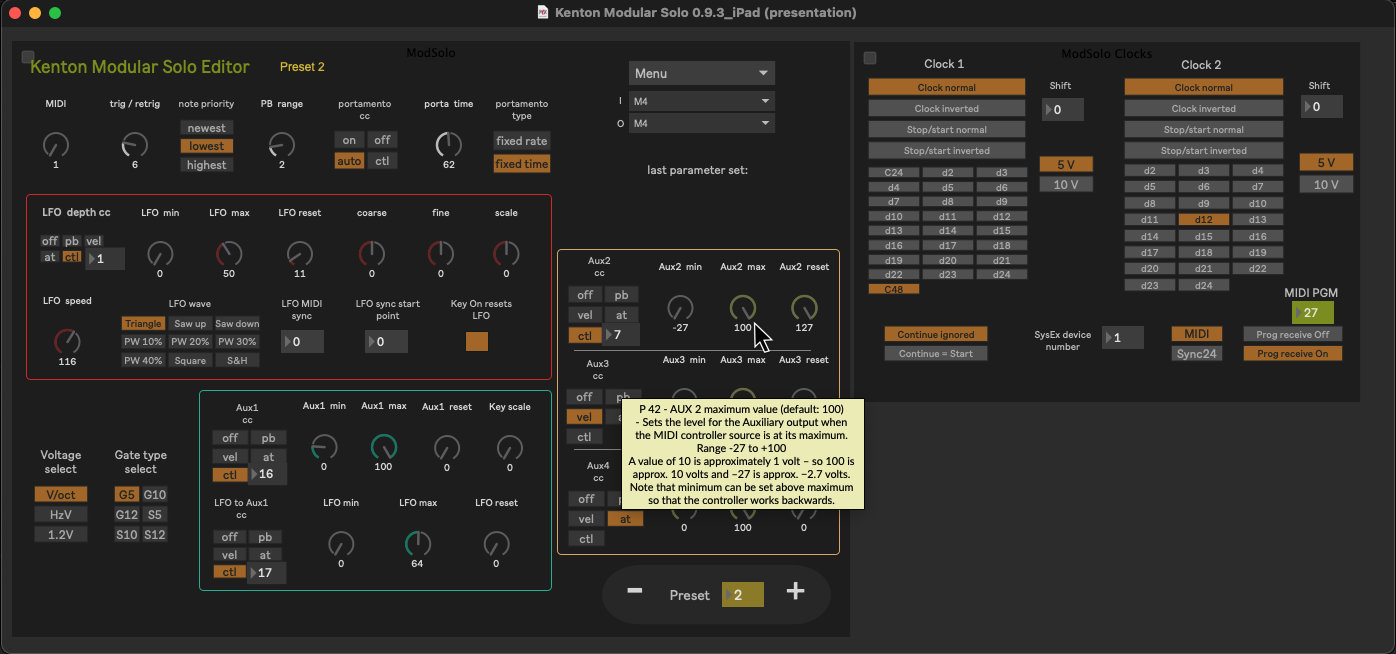
 Finally, I added the option of saving the programs to and loading them from a hard disk to my Editor - after all, it is an Editor and that also requires a “Library”. The module has 32 program slots and the programs can also be called up (without Editor) using MIDI Program Change commands. Some users will probably wish to save small alterations, e.g. to the Pitchbend Range, the LFO settings, etc., as a Preset and recall it via MIDI PGM Changes. However, if, for example, the LFO waveform, speed or Portamento Rate are to be altered spontaneously or via controllers (in real time) while playing, SysEx is the way to go.
Finally, I added the option of saving the programs to and loading them from a hard disk to my Editor - after all, it is an Editor and that also requires a “Library”. The module has 32 program slots and the programs can also be called up (without Editor) using MIDI Program Change commands. Some users will probably wish to save small alterations, e.g. to the Pitchbend Range, the LFO settings, etc., as a Preset and recall it via MIDI PGM Changes. However, if, for example, the LFO waveform, speed or Portamento Rate are to be altered spontaneously or via controllers (in real time) while playing, SysEx is the way to go.
The MIDI settings of the Editor can be saved and are automatically loaded when the Editor is being opened.
My MAX Yamaha TX81Z Editor
I already owned a Yamaha TX81Z synthesizer (from 1987) since 5 years, and although I like it exceptionally well, I have almost never used it. The sole reason for this was the 19 inch synth (1U) is just awful to program on the unit itself. Now I have written myself an Editor - and got a second TX81Z (you can couple two of the 8-voice TC81Zs and get a 16-voice TX81Z).
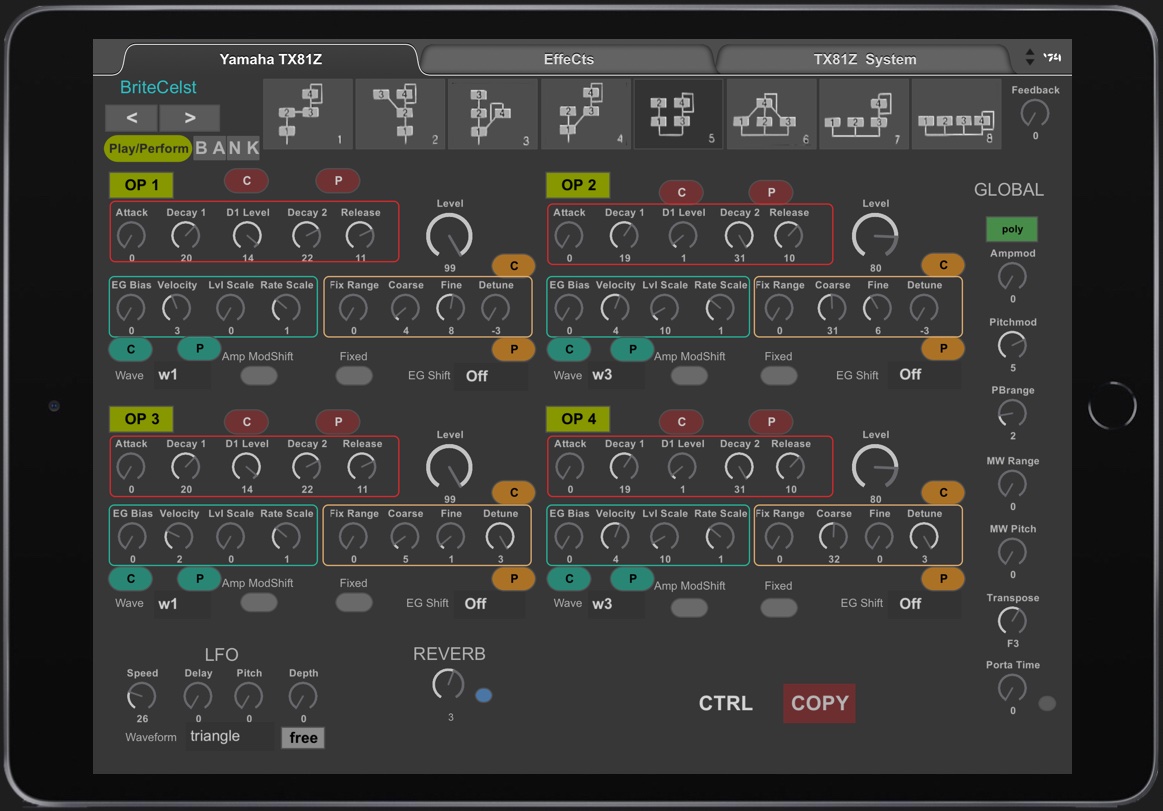
Meanwhile the Editor has "grown" and is a "Full TX81Z Editor" now. I wrote a longer description about it on this website - it's here:
A "Live Electronic Setup"
Between 2018 and -20 I programmed a software for the pianist / trumpeter Matthias Mainz. The central starting point was to make a virtual piano sound microtonally tunable in order to extend an acoustic grand piano with it and to mix the overall sound in such a way that the result appears as a (single) microtonally tuned instrument. A live looper (sampler) and three buffer sample players were included, which can then be connected and further processed by additional signal processors ( Filter, Delays, Shifter, RM, Doppler, etc.) across a Matrix, in combination with the live input.
The following video features this "PlaYeR/CoNtRoL" software from 2020: on the left is the "Terminal" - what can be seen on the computer display. In the upper right is the iPad's variable control interface. A more of an extreme example of what is possible with MAX. Everything is MAX, including the audio processing (DSP), also AU and VST plug-ins are to be loaded - so: a complete electronic setup played via MIDI keyboard and an iPad.
PlaYeR / ConTroL
MAX - Impact on my life
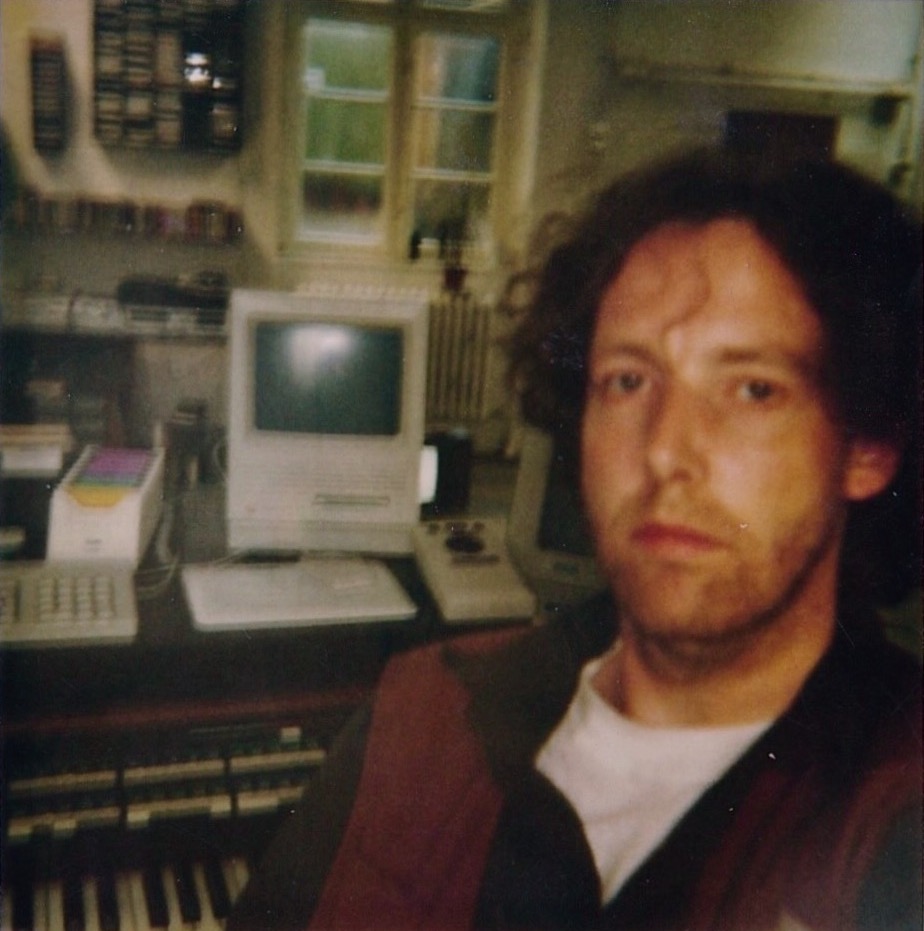 In 1990, about half a year before MAX was released (by Opcode), Bruno Spoerri called my attention to the "Programming Environment" and invited me to Oetwil am See (in Switzerland), where David Zicarelli held a MAX Introduction for a couple of days. This led, after MAX was released, to being hired in order to introduce MAX at various universities and expos (which allowed me to finance the Apple SE30 (see Image) that I so desperately needed for MAX). This was more than 30 years ago - and resulted in the biggest transition in my life.
In 1990, about half a year before MAX was released (by Opcode), Bruno Spoerri called my attention to the "Programming Environment" and invited me to Oetwil am See (in Switzerland), where David Zicarelli held a MAX Introduction for a couple of days. This led, after MAX was released, to being hired in order to introduce MAX at various universities and expos (which allowed me to finance the Apple SE30 (see Image) that I so desperately needed for MAX). This was more than 30 years ago - and resulted in the biggest transition in my life.
Due to the early encounter I had entered into a new "family" - at that time Computers had not yet been in everyone's household and concerning my very expensive Apple SE30 (on the Polaroid photo from 1991) the most common sentence I heard was:
"No one needs a 40MB Hard Drive!"
- a phrase that, as we know, did not get the time for aging.
MAX was an incredible shortening of the road. Interesting things were practically instantly possible, which could then also be immediately implemented musically! At that time I was just learning C Programming - on the photo you can see the first (yellow) Floppy Disk, which is a Symantec "Think C". It was hardcore and needed already quite a few months to even compile a first musical function - with which, however, nothing could be done yet.
At that time, I was mainly working with my Rhodes Chroma and an EES MIDI interface (a custom build for the Chroma). The big "problem" with the Chroma was that it only had one single Slider for changing previously selected parameters, and MAX now allowed me to access all the desired Parameters at the same time. Nevertheless, " Computer Music" was still a difficult thing to evaluate.
 Five years later, MAX still was very exotic for most people, but Computers were popularizing - and "the more creative" musicians mostly had Apple computers. By now it was obvious that computers would play the central role in the future of Electronic Music. Meanwhile, through my connection to the "Electronic Studio of the Music Academy Basel", I had a real-time DSP system, M.A.R.S., which was still far ahead of its time that I operated using MAX. Another unmistakable sign for the continued existence of MAX was the fact that I was invited for an interview by the "KEYS" magazine when the MAX 3.0 test report was published. This magazine represented a completely different direction and was rather a "main street magazine". In universities, MAX already had evolved into the standard and the live electronics were typically controlled using MAX patches.
Five years later, MAX still was very exotic for most people, but Computers were popularizing - and "the more creative" musicians mostly had Apple computers. By now it was obvious that computers would play the central role in the future of Electronic Music. Meanwhile, through my connection to the "Electronic Studio of the Music Academy Basel", I had a real-time DSP system, M.A.R.S., which was still far ahead of its time that I operated using MAX. Another unmistakable sign for the continued existence of MAX was the fact that I was invited for an interview by the "KEYS" magazine when the MAX 3.0 test report was published. This magazine represented a completely different direction and was rather a "main street magazine". In universities, MAX already had evolved into the standard and the live electronics were typically controlled using MAX patches.
A particular memorable occasion for me was when, in 1999, after a concert in San Diego, during dismantling, Miller Puckette came up to me on stage, introduced himself and said some quite flattering things to me. We befriended quickly and it was an interesting experience to become familiar with the Mastermind behind MAX. A thoroughly exceptional and an impressively benign human being!
You will find, of course, much more MAX on my website because I actually realize all my music-electronic projects with MAX. Obviously under "The Live Electronic" (Programming) and "Control" (Programming). Under "My "Hybrid Modular"" (Synthesizer) I show how to control analog synthesizer modules from the computer (or controller) and a little more.



